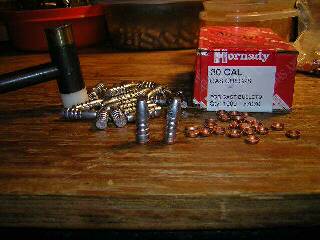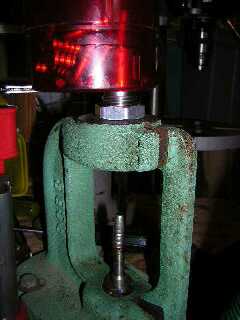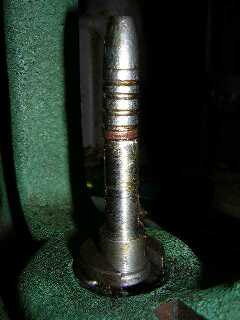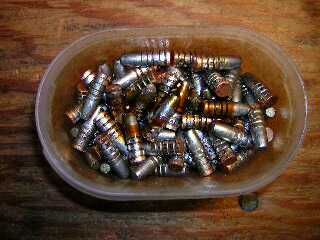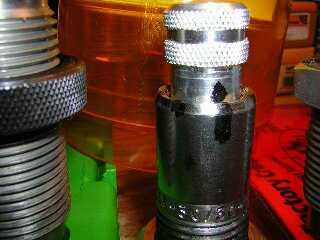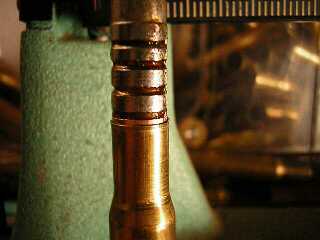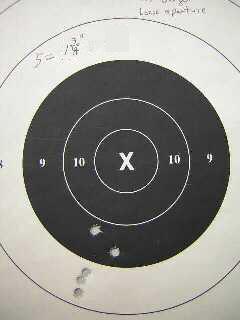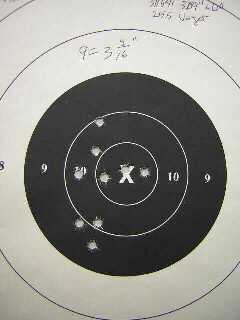Winchester Model 94
Copyright 2005 by Junior Doughty
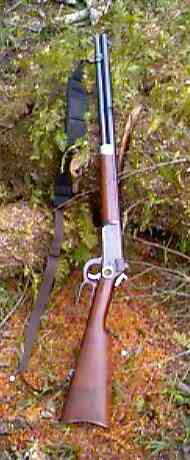 As the reader knows if he or she read my previous two articles about cast bullets in a 30-30, Ol' Bill, on the right, is a Buffalo Bill Commemorative Winchester Model 94 30-30. He's a fine cast bullet shooter, probably due to his heavy 20" octagon barrel. But he's too heavy for packing around the woods, and his silver ornamentation is too bright for hunting. So I promoted him to a higher position: cast bullet target rifle.
As the reader knows if he or she read my previous two articles about cast bullets in a 30-30, Ol' Bill, on the right, is a Buffalo Bill Commemorative Winchester Model 94 30-30. He's a fine cast bullet shooter, probably due to his heavy 20" octagon barrel. But he's too heavy for packing around the woods, and his silver ornamentation is too bright for hunting. So I promoted him to a higher position: cast bullet target rifle.I removed the sling and the rear stud. I replaced the factory front sight with a Lyman 17AHB target sight. I replaced the Williams 5D rear peep with a Lyman 66 click-adjustable peep. Being lazy by nature, and finding factory cast 30-30 bullets dirt cheap, I ordered 500 each from two different companies. Alas, they shot poorly at 100 yards due to their too-small noses, i.e. .297" and .292". (Click here for more about them.) Then I discovered a guy with a now-closed home bullet casting business. He informed me that the 173 gr Flat Point 30-30 bullet he sold was cast from an off-the-shelf Lyman 311041 two-cavity mold. That mold, I figured, should drop bullets near or at Bill's .300" bore size. If so, they ought to shoot well at 100 yards. After some negotiation, he agreed to sell me 500 of those bullets as cast, sans lube and gas check. The price, including shipping, was $35. They averaged 173.58 grs. As a Hornady 30 caliber gas check weighs on average 4.45 grs, the bullet's final weight sans lube was 178.03 grs.
The perfect-diameter nose worked like a charm in Bill's .300" barrel. They shot fine at all ranges. Wasn't long, I ran out of bullets. After more negotiation, I bought 1,000 of those bullets as cast, sans lube and gas check. The price, including shipping, was $65. Adding the cost of a gas check plus a smidgen for lube, those bullets cost me maybe 9¢ each, including shipping. The cheapest 170 gr jacketed bullets I could find in a catalog were Remington 170 gr SP @ $11.97 per hundred (2-21-05), plus shipping, from MidSouth Shooters Supply. They would come through my door at about 16¢ each. That's high. Besides, who'd want a nasty ol' jacketed bullet messing up his 30-30 barrel?
I would use those new 311041 bullets for plinking and casual target shooting. I also had some new loading goodies to try with them. The new goodies were:
Let's load!
We'll begin with putting gas checks on the 311041 bullets and lubing them. We'll use Lee Liquid Alox (LLA), so we must install the gas checks before lubing. There's two reasons for that:
Warning: If you hit the nose of the bullet too hard, it will bump up slightly in diameter. Read that flyer. I dropped each gas-checked bullet into the small plastic storage container you see behind the red Hornady gas check box. When the container was about 3/4 full, I stopped seating gas checks and squirted some LLA on top of the bullets. Then I put the lid on the container and rattled it around, spreading lube over all of the bullets.
Note the wet bullet sitting on the "bullet punch," as Lee calls it, which is installed in the press's ram in place of a shell holder. To size the bullet, you lower the press handle and force the bullet up and through the die which is installed in the press. Needless to say, don't try to size an un-lubed bullet. After about three bullets in the die, sized bullets start falling out its top and into the red plastic box, which performs double duty as a storage container for the die, the bullet punch, and a bottle of LLA. Warning: The transition of a .311" diameter hard-cast bullet through a .309" diameter sizing die is a tough one. It takes more than a little force on the handle of a press. I suggest a cast iron press and a sturdy bench—a sturdy bench connected to the wall behind it. . . .
Notice the bullet punch fitting into the slot in the ram where a shell holder would normally fit. Notice the bullet cocked slightly to the right. That's because the gas check isn't fully seated. Don't worry. The force on the base of the bullet/gas check during the upward trip through the .309" sizing die will seat the gas check 100% straight. However, the force required to push the bullet/gas check through a .311" sizing die is not enough to fully seat every gas check. All bullets to be sized .311" require a gentle whack on their noses with a rubber hammer. The batch of bullets sized, I dumped the red plastic hopper into the clear plastic storage container and gave them another shot of LLA—coat #2 and the final one.
The Lee sizing die instructions advise the user to spread the bullets out on wax paper and let them dry. Don't do that. The bullets will have a thick coat of lube on their down side and a thin coat of lube on their up side. Use a plastic container with a lid. After the first rattling session, take off the lid so air can get to the bullets. About fifteen or twenty minutes later, re-install the lid and rattle some more. Repeat as needed. Your bullets will soon be evenly coated with lube. The container you see is an 11 oz Rubbermaid® and holds 100 to 150 bullets. I basically filled it with bullets until I started running out of rattling room.
More loading. . . .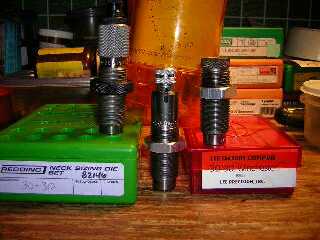 Here's three of the four 30-30 dies I used. On the left and on the box in which it came, see a Redding neck die. On the right and on the box in which it came, see a Lee Factory Crimp Die. In the center and in front of the round, yellow box in which it came, see a Lee Dead Length Bullet Seater die. Notice the hand-written chart barely visible inside the yellow Lee box. We'll return later to that chart. Here's three of the four 30-30 dies I used. On the left and on the box in which it came, see a Redding neck die. On the right and on the box in which it came, see a Lee Factory Crimp Die. In the center and in front of the round, yellow box in which it came, see a Lee Dead Length Bullet Seater die. Notice the hand-written chart barely visible inside the yellow Lee box. We'll return later to that chart.I adjust the Redding neck die to fully size the entire neck, and I use the expander which came with the die. I use the seating die which came with the set as a paperweight. I should have bought just the neck die and saved about $10.00. I adjust the Lee Factory Crimp Die for maximum crimp. I use Varget powder for all my 30-30 loads, and for best burning efficiency Varget likes higher pressure. These loads would only be mild 1725 fps loads using 25.5 grs of Varget, so a heavy crimp helps Varget burn evenly. Now, about the chart inside the yellow Lee box. . . . The Lee Dead Length Bullet Seater die came in that box as part of a 30-30 Lee Collet Die neck-sizer set. I use the collet die as a paperweight. However, the Dead Length Bullet Seater die is a jewel. With a little work with a permanent marker, it's a freebie micrometer in-line bullet seating die.
In the photo above, I could turn the adjustment screw clockwise to the small black dot at the -1/8 turn mark, and I would decrease bullet seating depth by .007". For the loads in this article, I used the +1/4 turn mark which put the first band of the bullet in the edge of the lands.
Size & deprime. . . .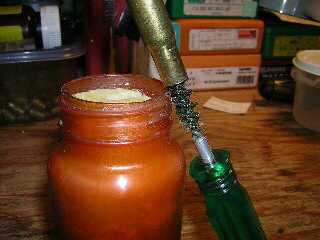 I lubed the case neck insides with a plastic brush wet with a small amount of RCBS case sizing lube. I lubed the case neck insides with a plastic brush wet with a small amount of RCBS case sizing lube. The case neck outsides were finger-lubed with just a trace of Junior Lube from the bottle you see here. I wiped my finger across the top of the Junior Lube, then ran the finger around a case neck. I did not clean the RCBS case lube from inside the necks before seating the bullets. I did not clean the Junior Lube from the case necks before firing the loaded rounds. This is supposed to be easy, remember?
Die #4, expand the case mouth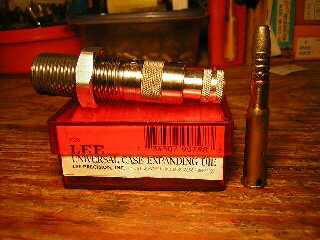 After cleaning the primer pockets and repriming with CCI BR2 primers, I belled the case mouths with a Lee Universal Case Expanding Die.
After cleaning the primer pockets and repriming with CCI BR2 primers, I belled the case mouths with a Lee Universal Case Expanding Die.Here we see the die—truly universal as I use the same die for loading cast in 30-30, 357 mag, and 45-70. To the right of the die, see a bullet sitting in a belled case mouth. I like to bell the mouth just enough for the gas check to barely enter the neck. The more you bell, i.e., flare, the case mouth the sooner you'll have a split neck. In the full-size version of the photo you can easily see the slight bell at the very top of the case neck. One reason I like the Lee expanding die is because it does nothing to the case neck but bell the mouth. M dies bell the mouth, but they also expand the entire neck to the diameter of the M die's expander plug—which may not be the diameter needed for the best accuracy. I expanded my case necks to the diameter of my Redding neck sizer die's expander plug—about .002" smaller in diameter than my M die's plug. That means more neck tension on the bullet which means more pressure for the Varget powder which means more efficient burning and . . . gives better accuracy.
Charging the case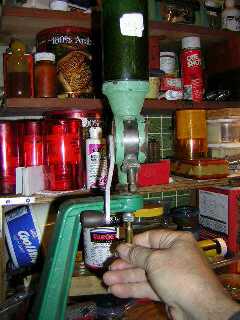 I used my RCBS Uniflow measure mounted in my bench vise. The measure throws charges within ± .1 gr. I used my RCBS Uniflow measure mounted in my bench vise. The measure throws charges within ± .1 gr.The white tag you can't read on the hopper is labeled 25.5 grs Varget, i.e., the measure setting and the powder it contains. I used that setting for these mild 30-30 loads because the setting is the same for my 7mm TCU loads, which use 25.5 grs of Varget. It makes things simpler if you don't have to change settings. And I'm lazy, I think I mentioned earlier. I charge all the cases I intend to load and put them in a loading block. I then put the block full of cases under a light and look down inside the cases. That way, it's easy to tell if one is missing a charge or contains a partial charge. The Voice Of Experience just spoke—listen!
Seat the bullets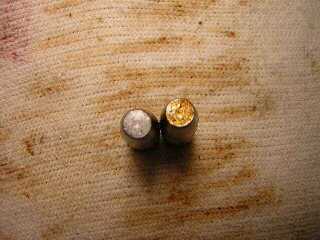 The first thing we must do is get the LLA lube off the bullet noses. Just a little lube on a nose will cause deeper bullet seating, and a build up of lube on the seater plug will sooner or later cause much deeper bullet seating. The first thing we must do is get the LLA lube off the bullet noses. Just a little lube on a nose will cause deeper bullet seating, and a build up of lube on the seater plug will sooner or later cause much deeper bullet seating.So just before I seat each bullet, I wipe its nose across a rag. Here we see a clean nose, a dirty nose, and a rag with lots of wiping evidence.
Let's shoot!The 311041 bullets sized .311" gave me several sub-2", 5 shot, 100 yard groups, including one measuring an almost unbelievable 1 3/8". (Which I forgot to photograph!) However, most groups contained a flyer which opened the groups to 5" or so. I suspect the problem is an occasional pressure spike caused by the swaging down from .311" to the bore's .308".
But the group looked like it might be a good one, so I kept firing. When I fired the 5th and last shot, a piece of metal flew off Bill's action, hit the bench, and bounced inside the cuff of my shirt sleeve. I just knew I had blown up my favorite rifle. But a look-over showed no visible damage. I dug inside my shirt sleeve and came out with . . . the aperture! So I shot the good group while the aperture dangled from its threads.
After shooting this group I moved the sight's windage adjustment 3 clicks to the right, and that's where the zero will probably stay. The POI is nicely centered around the X.
The 311041 bullets are inexpensive and easy to size, lube, and load. Sized .309" they give me consistent 2 1/2" to However . . . those dang flyers messing up otherwise tiny groups shot with .311" sized bullets sure make me scratch my head in wonderment. That 1 3/8" group was the best 100 yard 5 shot group I ever shot with iron sights. Maybe if I. . . .
| ||||||||||||||||||||||
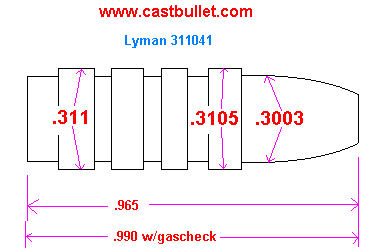 The not-to-scale gif on the right shows the micrometer results.
The not-to-scale gif on the right shows the micrometer results.